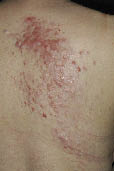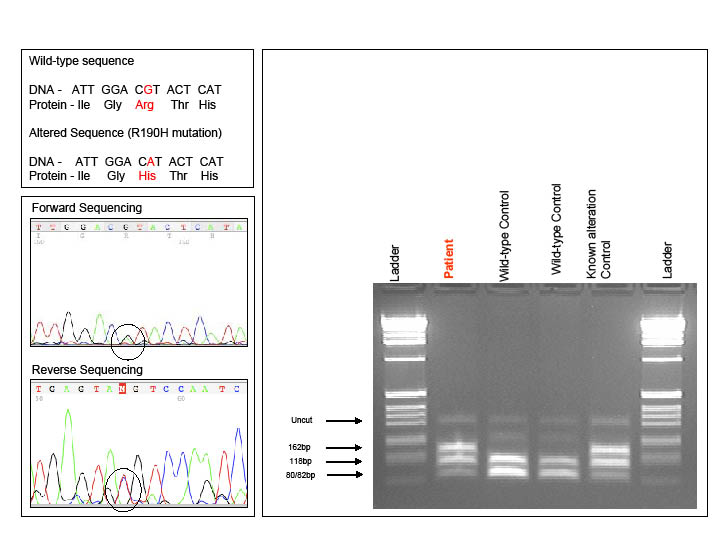Sir,
Cutaneous leiomyomata are benign tumours of the skin deriving from the erector pili muscle of the hair follicle. Cutaneous leiomyomata may present as a solitary lesion, but in 80% of cases several lesions occur simultaneously, with either a disseminated or segmental pattern (1, 2). If cutaneous leiomyomata in women are associated with uterine leiomyomata this condition is called multiple cutaneous and uterine leiomyomatosis (MCUL) (3, 4) and a disease variant involving aggressive renal cancer can occur in some patients, then referred to as hereditary leiomyomatosis and renal cell carcinoma (HLRCC) (5, 6). Recently, it has been shown that patients with MCUL/HLRCC have germline mutations in one copy of the gene encoding for the Krebs cycle enzyme fumarate hydratase (FH) (7).
We report here a case of segmental cutaneous leiomyomatosis. Sequencing of the FH gene revealed a R190H mutation, previously known to be involved in the development of cutaneous leiomyomatosis.
CASE REPORT
A 46-year-old woman presented for evaluation of intermittently painful papules and nodules on her right upper back and the right side of her neck. She first noticed the lesions on her back at the age of 16 years; during the following years the lesions slowly increased in size. The papules were sensitive to touch and temperature. Apart from these symptoms she was in good general health. Her past medical history included hysterectomy in her third decade of life due to severe uterine leiomyomata. The family history was negative for skin or gynaecological diseases. She has two healthy daughters.
Clinical examination revealed multiple firm, pink-red papules and nodules on the right upper side of her back and on the right side of her neck (Fig. 1). The lesions showed a segmental distribution pattern; other parts of her skin and her mucous membranes were not affected.
Fig. 1. Clinical features of the patient: segmental distribution pattern of the skin leiomyomata on the back.
Histopathology revealed proliferation of spindle-shaped cells distributed in the whole dermis. The cells were arranged in interlacing bundles and fascicles. The cells showed eosinophilic cytoplasm and elongated nuclei with blunt ends. Immunohistochemical staining for actin and desmin was positive. The histological findings supported the clinical diagnosis of cutaneous leiomyomatosis and, together with her past medical history of early hysterectomy due to severe uterine leiomyomata, MCUL was the most probable diagnosis.
To further investigate for an underlying mutation, genomic DNA from peripheral blood was used for sequence analysis. Analysis of the FH gene on chromosome 1q42.3–q43 revealed a G to A transition in exon4 of one copy of the gene (Fig. 2). This change leads to the amino acid substitution R190H in the protein, which has previously been shown to reduce the activity of FH (8). Since it has been reported that there is an increased risk of developing renal cell carcinoma in families with cutaneous leiomyomatosis carrying the R190H mutation (7–9), we referred our patient to the department of nephrology for further examination, but no evidence of renal cancer was found.
Fig. 2. DNA sequencing showing the altered sequence (R190H mutation) (left panel). Digestion with restriction enzyme Rsal cutting DNA in wild-type, but not altered, sequence (right panel).
The treatment of cutaneous leiomyomata is only symptomatic and dependent on the individual discomfort and pain in every patient. Treatment options include surgical excision, dermabrasion and carbon dioxide laser ablation (2, 10, 11). Since the lesions in our patient were relatively widespread, we refrained from surgical intervention, and carbon dioxide laser ablation in a small testing area gave no convincing results. Our patient reported that the lesions were painful only occasionally and so decided against therapy.
DISCUSSION
In our patient the clinical and histological findings of cutaneous leiomyomatosis, together with the underlying R190H mutation, led to the diagnosis of MCUL/HLRCC. The clinical features our patient displayed were typical, as reported in a recent study of 108 individuals affected with MCUL, which analysed the clinical features and the underlying mutations (12). Of all probands with multiple cutaneous leiomyomatosis, the vast majority (89%) showed evidence of a germline FH mutation, of all women with FH mutations the majority (69%) had both skin and uterine leiomyomata and only one patient had aggressive renal cell cancer. Among the clinical features of the skin leiomyomata, the disseminated form was most common, followed by a segmental pattern distribution, as present in our patient, and the combination of both (12).
Some years ago the concept of two types of segmental manifestation of autosomal dominant skin disorders was proposed (13) and it was also noted that, especially in cutaneous leiomyomatosis, type 2 is rather frequent (14). In the type 2 segmental manifestation, loss of heterozygosity in a heterozygous embryo leads to more severe skin lesions in the segmentally affected skin areas. The very pronounced segmental manifestation of MCUL in our patient probably reflects mosaicism, and assuming that the patient carries a germline mutation this would imply that she has a type 2 segmental manifestation. Unfortunately, her parents were not available for genetic analysis, so that we can only hypothesize that her mother also carried the mutation since she also underwent hysterectomy due to severe uterine leiomyomata at the early age of 30 years.
Cutaneous leiomyomatosis, especially the segmental variant, is a relatively rare benign skin disease. However, given the fact that in some cases of MCUL/HLRCC this disease might be associated with renal cell cancer, it is important to be aware of this potential association and perform further examination of the patients diagnosed with cutaneous leiomyomatosis. To date, no particular mutation in the FH locus has been directly correlated with placing an individual at risk of developing renal cancer. It has been suggested recently that other genetic factors separate from the FH locus may affect a patient’s risk of developing renal cancers (15). Furthermore, no guidelines regarding screening strategies for renal cancer in individuals diagnosed with FH mutations exist. Since there were reports on patients with the R190H mutation developing renal cancer, we referred our patient for nephrological evaluation followed by yearly check-ups.
Recently, a number of other tumour types have been associated with germline FH mutations, including Leydig cell tumours (16), breast and bladder cancers and kidney cysts (17). Thus, this condition has apparently far-reaching implications beyond its more prevalent symptoms.
REFERENCES
1 Agarwallaa A, Thakur A, Jacob M, Joshi A, Garg VK, Agrawal S. Zosteriform and disseminated lesions in cutaneous leiomyoma. Acta Derm Venereol 2000; 80: 446.
2 Smith CG, Glase DA, Leonardi C. Zosteriform multiple leiomyomas. J Am Acad Dermatol 1998; 38: 272–273.
3 Alam NA, Bevan S, Churchman M, Barclay E, Barker K, Jaeger EE, et al. Localization of a gene (MCUL1) for multiple cutaneous leiomyomata and uterine fibroids to chromosome 1q42.3-q43. Am J Hum Genet 2001; 68: 1264–1269.
4 Martinez-Mir A, Gordon D, Horev L, Klapholz L, Ott J, Christiano AM, Zlotogorski A. Multiple cutaneous and uterine leiomyomas: refinement of the genetic locus for multiple cutaneous and uterine leiomyomas on chromosome 1q42.3-q43. J Invest Dermatol 2002; 118: 876–880.
5 Kiuru M, Launonen V, Hietala M, Aittomaki K, Vierimaa O, Salovaara R, Arola J, et al. Familial cutaneous leiomyomatosis is a two-hit condition associated with renal cell cancer of characteristic histopathology. Am J Pathol 2001; 159: 825–829.
6 Launonen V, Vierimaa O, Kiuru M, Isola J, Roth S, Pukkala E, et al. Inherited susceptibility to uterine leiomyomas and renal cell cancer. Proc Natl Acad Sci 2001; 98: 3387–3392.
7 Tomlinson IP, Alam NA, Rowan AJ, Barclay E, Jaeger EE, Kelsell D, et al. Germline mutations in FH predispose to dominantly inherited uterine fibroids, skin leiomyomata and papillary renal cell cancer. Nat Genet 2002; 30: 406–410.
8 Alam NA, Rowan AJ, Wortham NC, Pollard PJ, Mitchell M, Tyrer JP, et al. Genetic and functional analyses of FH mutations in multiple cutaneous and uterine leiomyomatosis, hereditary leiomyomatosis and renal cell cancer, and fumarate hydratase deficiency. Hum Mol Genet 2003; 12: 1241–1252.
9 Toro JR, Nickerson ML, Wie M, Warren MB, Glenn GM, Turner ML, et al. Mutations in the fumarate hydratase gene cause hereditary leiomyomatosis and renal cell cancer in families in North America. Am J Hum Genet 2003; 73: 95–106.
10 Archer CB, Greaves MW. Assessment of treatment for painful cutaneous leiomyomas. J Am Acad Dermatol 1987; 17: 141–142.
11 Christenson LJ, Smith K, Arpey CJ. Treatment of multiple cutaneous leiomyomas with CO2 laser ablation. Dermatol Surg 2000; 26: 319–322.
12 Alam NA, Barclay E, Rowan AJ, Tyrer JP, Calonje E, Manek S, et al. Clinical features of multiple cutaneous and uterine leiomyomatosis. Arch Dematol 2005; 141: 199–206.
13 Happle R. Segmental forms of autosomal dominant skin disorders: different types of severity reflect different states of zygosity. Am J Med Genet 1996; 66: 241–242.
14 Badeloe S, van Geel M, van Steensel MAN, Bastida J, Ferrando J, Steijlen PM, Frank J, Poblete-Gutierrez P. Diffuse and segmental variants of cutaneous leiomyomatosis: novel mutations in the fumarate hydratase gene and review of the literature. Exp Dermatol 2006; 15: 735–741.
15 Kokko A, Ylisaukko-Oja SS, Kiuru M, Takatalo MS, Salmikangas P, Tuimala J, et al. Modelling tumor predisposing FH mutations in yeast: effects of fumarase activity, growth phenotype and gene expressin profile. Int J Cancer 2006; 118: 1340–1345.
16 Carvajal-Carmona LG, Alam NA, Pollard PJ, Jones AM, Barclay E, Wortham N, et al. Adult leydig cell tumors of the testis caused by germline fumarate hydratase mutations. J Clin Endocrinol Metab 2006; 91: 3071–3075.
17 Lehtonen HJ, Kiuru M, Ylisaukko-Oja SK, Salovaara R, Herva R, Koivisto PA, et al. Increased risk of cancer in patients with fumarate hydratase germline mutation. J Med Genet 2006; 43: 523–526.





